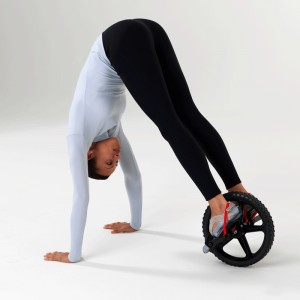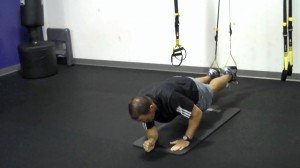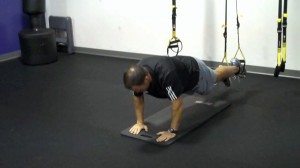Brian Schiff’s Blog
Injury Prevention, Sports Rehab & Performance Training Expert
Long lever abdominal exercises are popular. However, they also pose a risk for the lumbar spine given the relatively poor abdominal strength/control and lever arm created by momentum and the iliopsoas muscle. The stress on the lumbar spine is high as the leg (s) come back down due to reverse muscle action via the attachment of the iliopsoas on the lower lumbar spine. As a result, this can cause a sizable shear force on the spine.
I counsel patients and athletes with prior history of disc pathology to be very careful with any long lever or ballistic abdominal exercises with straight legs as the physics may present higher risk than reward and create excess strain on the spine. While a single workout may not cause harm, there can be a gradual repetitive overload that creates weakness or harm to the disc and/or spine. This exercise from my Functionally Fit column promotes strength and core or pillar stability through resisting excessive spinal extension.
I readily admit I have had an aversion to abdominal exercises that involve straight leg lowering since my days in pee wee football where we were forced to do lifts and holds a few inches above the ground. Some will relate to a modern day version of this exercise known as “six inches.”
As someone with tight hip flexors and who has personally suffered from sciatica in the past, I am NOT a fan of abdominal training that exposes the lumbar spine to large loads and undue risk related to exercises that involve long levers (e.g. throw downs, scissors, etc) and place high shear force on the spine.
I was reminded of why I feel this way in a fitness class this past week. I take a cycle/core class at my local gym and have done a traditional spinning class twice per week for 3 years. After 45 minutes of cycle, we move to a fitness room for core. I have done this new format for three weeks. This week we were asked to do a series of exercises which included “banana rolls.” If you are unfamiliar with this move, check out You Tube for some video demos.
While this exercise may be effective for core strengthening, I can honestly say as one who has never done the move before that trying to execute it as part of a continuous sequence of movements without rest between the moves was very hard to do with proper form. The fatigued state encouraged using momentum and straining to simply get the movement done (not to mention the fact my greater trochanter was sore from the rolling on the hard aerobic floor).
The next day I woke up with low back pain. My back has not hurt like that in years. In light of the role the iliopsoas plays by virtue of its attachment on the lumbar spine, we must consider the impact of reverse muscle action and how it creates shear on the lumbar spine during movements that rely on stabilization with the legs extended against gravity. Additionally, for those clients like me with muscle tightness, increased lumbar lordosis and a history of low back disorders, health and fitness professionals must consistently evaluate safety and efficacy as well as trying to challenge clientele in a workout session.
For all of these reasons, I increasingly rely on neutral spine anti-extension and anti-rotation training exercises in my programming for athletes and clients of all ages and abilities. That is not to say I never do rotational or active movements. They are appropriate given the right order, progression and demands of the respective individual. I just think we must consider form and risk versus reward in exercise programming.
The exercise video below illustrates how to use sliders in a tall plank position to accomplish great core activation and hip/shoulder stability without stressing the lumbar spine with long lever movements. Keep in mind that quality should override quantity in terms of deciding repetition schemes. Do not let the desire to fatigue clients cause form to suffer as this may increase injury risk.
For more specifics on the execution and progression/regression of this particular exercise, click the link below to read my most recent exercise column for PFP Magazine.
Suffice it to say I will not be doing banana rolls again. While I am not completely discarding the exercise, I do think it should be done in a non-fatigued state and taught incrementally if done at all. Most importantly, we as fitness professionals must always remember to program exercises based on fatigue and skill level, while carefully weighing risk versus reward in group or individual sessions.
With the new year, millions of people have made a resolution to lose weight. Along with that, comes the idea they will flatten their midsection. If you are like me, you share a certain disgust for the infomercials marketing the “next” latest and greatest abdominal machine.
For years, people have sought out how to build the perfect six pack. Obviously, nutrition is probably the single biggest factor in achieving a sculpted midsection. But, beyond that people often wonder what exercises to do to target the upper and lower abs as well as the obliques. Is this really possible?
Well, I thought I would share the results of a recent study in the Journal of Strength & Conditioning Research. The authors wanted to look at the use of other training tools versus just a body weight only exercise. In the study, they looked at surface EMG activity for the upper rectus abdominus (URA), lower rectus abdominus (LRA), external obliques (EO), internal obliques (IO), transverse abdominus (TA) and rectus femoris (RF) with the following exercises:
- Abdominal floor crunch
- Supine V-up
- Prone V-up on slide board
- Probe V-up on stability ball
- Probe V-up on TRX
- Prone V-up on power wheel

Crunch

Prone V-up with power wheel
In short the major results are as follows:
- The most muscle activity overall occurred with the power wheel
- There was no significant difference for activation of the EO, URA and LRA
- RF was much less active only during the abdominal crunch
Practical applications include:
- There is no realistic way to isolate portions of the abdominal muscles, but keep in mind one limitation may be that the study looked at MVC (contraction at only one point in the motion)
- The RF is NOT a spinal stabilizer but rather a hip flexor and therefore it can cause an anterior pelvic tilt if overly active which can be viewed as potentially harmful
- Focus on training the core globally as an integrated segment of the kinetic chain to maximize activation and understand how the hips affect completion of the movements
I hope this post stimulates your thinking with respect to abdominal training. If you do use training tools, simply stop for a moment to consider the desired training outcome, as well as the impact the body position and muscle firing patterns have on the exercise itself.
If you read my blog, then you know I contribute a column for PFP Magazine. I have been doing a series for them on TRX training as of late. My most recent column included an incredibly challenging exercise incorporating a plank and push-up.
Time is precious for many of us in the gym, so I am always looking for the best return on my time with each and every exercise I choose. While this one is not for the novice or inexperienced TRX user, I assure you it will be one you will love to hate! Scroll down to check out the column and see how many you can crank out before you fatigue.



Click here to read how to correctly perform the exercise, use a progressive build up series and understand the functional application. I hope you enjoy this as much as I do!
Finally, I want to wish all my American readers a Happy 4th of July!
Core training is common terminology thrown around in fitness circles today. However, not much research has specifically addressed more advanced stability ball exercises and muscle activation until now.
A recent article released in the May 2010 Journal of Orthopedic & Sports Physical Therapy looked at 8 stability ball exercises and maximal voluntary isometric contraction (MVIC) versus traditional bent knee curl ups and crunches.
The 8 stability ball exercises studied with EMG were:
- Roll out
- Pike
- Knee up
- Skier
- Prone hip extension left
- Prone hip extension right
- Decline push-up
- Seated march right

Pike (end position)
All exercises were performed with a cadence of 1/1/1. A metronome was used to ensure uniform repetitions and holds. Researchers concluded that the pike and roll-out were the most effective exercises based on EMG activation. However, keep in mind that these also require the greatest effort and pose a high degree of difficulty.
Why is this stuff important? Research done by Cholecki and VanVliet concluded that no single core muscle can be identified as the most important for spinal stability. Additionally, they believe that the relative importance of the muscle varies based on the direction and magnitude of the load imposed on the spine.
We have known for years the spine is least stable and most vulnerable in trunk flexion (as in the knee bent curl up), and that no one muscle contributes more than 30% to overall spine stability. Choosing more demanding core exercises also typically increases spinal compressive forces as well. This may be contraindicated in some populations.
Therefore knowing your client and condition is essential. For example, flexion is often contraindicated with active disk pathology, whereas it may be indicated in those with facet arthropathy or spondylolisthesis. Over the past decade or so, much attention has been placed on the transversus abdominus muscle.
The prevalent thinking has been that it is a major contributor to spinal stability, although this is somewhat controversial and has not been unequivocally validated with science. Another flaw here is that isolated contractions of it have not been demonstrated in higher level activities (e.g. sports).
So, where is the functional tie in here? The transeversus abdominus has shown similar activation patterns (within 15%) to the internal obliques with exercises similar to those in this study. The highest activity from internal obliques was during the pike, roll-out, knee up, skier and hip extension left exercise. This may indicate that transveresus abdominus activation is also high, but further research will need to be done.
The last critical piece of data involves looking at hip flexor activation as the psoas generates remarkable spinal compression and anterior shear forces at L5-S1. This can be especially troubling for individuals struggling with lumbar disk pathology. The exercise in this stud that demonstrated moderate hip flexor activation were:
- Bent knee sit-up
- Pike
- Seated march
- Hip extension exercises
So, if you or your client has a weak rectus abdominus and/or obliques or lumbar instability, these exercises may be contraindicated. In the end, know that the stability ball provides much greater muscle activation compared to traditional bent knee sit-ups and crunches on the floor. The caveat is identifying which ones are appropriate and most efficient in your case.
As a general rule, I suggest that you avoid long lever arm action with the legs in the presence of active disk pathology and instability. You may opt for stability based exercises in a neutral spine position like planks as there is minimal shear and compressive loading here until clients develop more stability and strength. With healthy and mroe advanced clientele, many of the stability ball exercises studied would be good alternatives to traditional crunch work to build muscle strength for the core.

